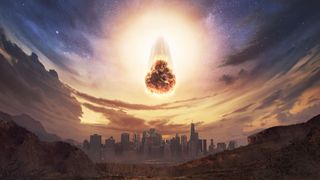With the Sun in our eyes an asteroid might go down on us. There is scope for hope thoigh.
In the glare of the sun, an unknown number of near-Earth asteroids move on unseen orbits. A new generation of infrared telescopes could be our best defense against potential disaster.
Any asteroid larger than 165 feet (50 m) across is capable of breaching Earth's atmosphere and striking the ground. The sun's glare could be blinding us to thousands of them. (Image credit: Nicholas Forder)
On the morning of Feb. 15, 2013, a meteor the size of a semitrailer shot out from the direction of the rising sun and exploded in a fireball over the city of Chelyabinsk, Russia. Briefly glowing brighter than the sun itself, the meteor exploded with 30 times more energy than the bomb that destroyed Hiroshima, exploding some 14 miles (22 kilometers) above the ground. The blast shattered windows on more than
7,000 buildings, temporarily blinded pedestrians, inflicted instantaneous ultraviolet burns and otherwise injured
more than 1,600 people. Fortunately, no known deaths resulted.
The Chelyabinsk meteor is thought to be the biggest natural space object to enter Earth's atmosphere in more than 100 years. Yet no observatory on Earth saw it coming. Arriving from the direction of the sun, the rock remained hidden in our biggest blind spot, until it was too late.
Events like these are, fortunately, uncommon. Rocks the size of the Chelyabinsk meteor — roughly 66 feet (20 meters) wide — breach Earth's atmosphere once every 50 to 100 years, according to an estimate from the
European Space Agency (
ESA). Larger asteroids strike even less frequently. To date, astronomers have mapped the orbits of more than
33,000 near-Earth asteroids and found that none pose a risk of hitting our planet for at least the next century.
But you can't calculate the risk of an asteroid you can't see — and there are untold thousands of them, including some large enough to destroy cities and potentially trigger mass-extinction events, moving on unknowable trajectories around our star, experts told Live Science. It's a harsh reality that has astronomers both concerned about the possible consequences and motivated to find as many of our
solar system's hidden asteroids as possible. Once we know about them, deadly asteroids can either be monitored and deflected if needed, or if all else fails, populations can be warned to relocate to avoid mass casualties.
"The most problematic object is the one you don't know about,"
Amy Mainzer, a professor of planetary science at the University of Arizona and principal investigator for two NASA asteroid-hunting missions, told Live Science. "If we can know what's out there, then we can have a much better estimate of the true risk." ...
https://www.livescience.com/space/a...-can-scientists-spot-them-before-its-too-late


